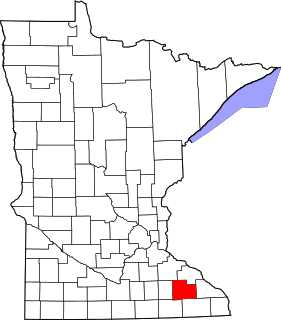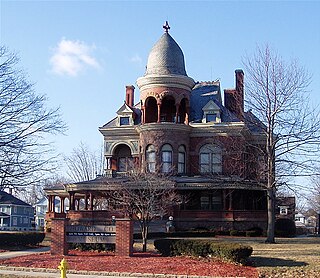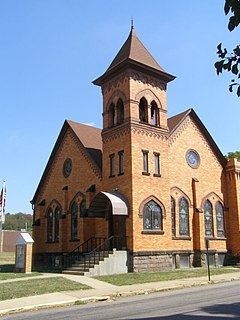
Victorian Village is a neighborhood in Columbus, Ohio, United States, north and near west of downtown. It is an established neighborhood built when a streetcar line first ran along Neil Avenue around 1900 with a fair number of established trees for an urban setting. To preserve, protect and enhance the unique architectural and historical features, the Victorian Village Historic District was established in 1973. Columbus Monthly named this neighborhood the top place to live for Arts and Entertainment, with fun right around the corner in the Short North as its neighborhood hangout.
Hunziker House refers to several historic houses in the United States; including Julius Hunziker House, Marge Hunziker House and O. F. Hunziker House. Hunziker House also refers to the "Casa Hunziker" found in Switzerland.
Daniel Parkhurst Leadbetter was a U.S. Representative from Ohio in Ohio during the 1840s.

Martin Welker was a United States Representative from Ohio and a United States District Judge of the United States District Court for the Northern District of Ohio.

Oxon Cove Park and Oxon Cove Farm is a national historic district that includes a living farm museum operated by the National Park Service, and located at Oxon Hill, Prince George's County, Maryland. It is part of National Capital Parks-East. It was listed on the National Register of Historic Places in 2003.

This is a list of the National Register of Historic Places listings in Butler County, Ohio.

This is a list of the National Register of Historic Places listings in Olmsted County, Minnesota. It is intended to be a complete list of the properties and districts on the National Register of Historic Places in Olmsted County, Minnesota, United States. The locations of National Register properties and districts for which the latitude and longitude coordinates are included below, may be seen in an online map.

The Barnesville Historic District consists of the oldest part of Barnesville, Ohio, originally platted in 1808 and contains roughly 40 acres and 180 buildings. The district was added to the National Register on July 19, 1984.

The Seiberling Mansion is a historic house located at Kokomo, Indiana, United States. In 1887, Monroe Seiberling of Akron, Ohio, traveled to Kokomo to open the Kokomo Strawboard Company, which would make shoeboxes out of straw and employ seventy-five people. Within six months, Seiberling, uncle of Goodyear Tire and Rubber Company founder Frank Seiberling, sold the Kokomo Strawboard Company and opened the Diamond Plate Glass Company. He began construction on his mansion in October 1889 at a cost of $50,000, with construction ending within two years. The mansion is built in a mixture of Neo-Jacobean and Romanesque Revival styles.

The Henry J. Wheeler Farm is a farmstead in Murray, Utah, United States, that one of the few remaining late 19th century farmsteads in the Salt Lake Valley that have not been lost to expanding housing developments of metropolitan Salt Lake City. It was listed on the National Register of Historical Places since 1976.\
Duncan & Miller Glass Company was a well-known glass manufacturing company in Washington, Pennsylvania. Items that were produced by the company are known as "Duncan glass" or "Duncan Miller glass." The company was founded in 1865 by George Duncan with his two sons and son-in-law in the South Side neighborhood of Pittsburgh, Pennsylvania. By 1890, the company joined other glass companies to form the United States Glass Company, a powerful glass trust. In 1892, the factory was destroyed in a fire, and the company was relieved of its trust relationship with the US Glass Company. After the fire, the second generation of the Duncan family moved operations to Washington, Pennsylvania. In 1900, John Ernest Miller, the company's long-time designer, became a full shareholder along with members of the Duncan family. By 1955, economic pressures from machine-produced glass forced the company to sell off its assets to the US Glass Company, who continued to produce Duncan-style glass until 1980.

Millersburg is a village that serves as the county seat of Holmes County, Ohio, United States located 66 miles (106 km) south of Cleveland. The population was 3,025 at the 2010 census. Holmes County Airport, located two miles southwest of Millersburg, serves the county.

Warder Public Library is a historically significant building in Springfield, Ohio, United States. A robust example of Richardsonian Romanesque architecture, it was a gift to the city from industrialist Benjamin H. Warder, and served as the main branch of the Clark County Public Library from 1890 to 1989. It now houses the Clark County (Warder) Literacy Center.

The John R. Twelves House is a historic house located in Provo, Utah, United States. It is listed on the National Register of Historic Places.

Rebersburg Historic District is a national historic district located at Miles Township, Centre County, Pennsylvania. The district includes 205 contributing buildings in Rebersburg. The district is almost exclusively residential with three churches, a small luncheonette, one grocery store and a post office. Among the types of residential building types present are the row house, connected or double houses, Continental four-over-four, Pennsylvania four-over-four, and Victorian Gothic type. Notable dwellings include the Jacob Major John Reynolds House (1820), Robert Tate House (1810), Daniel Walker House (1840), Philip Reitzell Tavern (1821), Colonel Henry Royer House (1823), John Bierly Sr., House (1830), Dr. John J. Hilbish House and Office (1853, Daniel Brungart House, Emma J. Royer House, and James E. Ziegler House.

William Frederick (W.F.) Garver was a judge from the U.S. State of Ohio who sat on the Ohio District Courts of Appeals and the Ohio Supreme Court during the 1930s.

Millersburg Christian Church is a historic Disciples of Christ church at 100 North Clay Street in Millersburg, Ohio. The earliest Christian Church was a frame structure built on this site in 1859. The brick building was constructed during 1903–04.

The Holmes County Courthouse is a historic government building in Millersburg, Ohio, United States. Built in the late nineteenth century, it has been designated a historic site because of its architectural importance.

George Crossman House is an historic home located in the East Falls Church section of Arlington, Virginia. It was built in 1892 by George Grant Crossman for his bride Mary Ellen (Nellie) Dodge of Lewinsville, VA. They married on April 7, 1892.


















